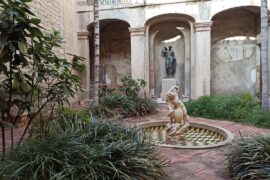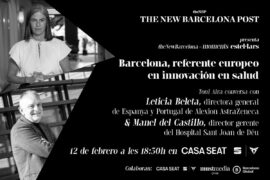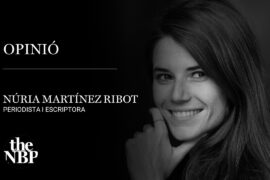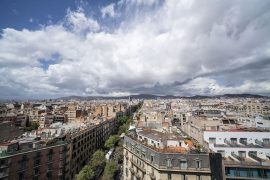[dropcap letter=”P”]
ablo Heras-Casado has claimed, like many other great artists of the past, the serious character of folk music. Music created by the people, transmitted from generation to generation, that composers like Igor Stravinsky or Manuel de Falla reformulated with new means and an inspiring radicality, demonstrating after all its universal reach. They were not alone, one of the most illustrious accomplices, Pablo Picasso, elaborated the scenery and wardrobe of ballets like Pulcinella or The Three-cornered Hat, both premiered in Paris exactly one hundred years ago, in 1919, commissioned by a visionary Serge Diaghilev, the artistic promoter that had already aroused a great scandal with the premiere of the Rite of Spring.
The founding composition of Stravinsky, that in 1913 provoked a true revolution, articulates sounds of the earth, guttural bellows, strident whispers, in short, impossibly natural blows of effect, illustrating thus the human need to dominate the elements. The anthropological dimension of the music, its essential presence in the time of celebration -we will go back, further on, to Claude Lévi-Strauss and Mircea Eliade- moved to the collective imaginary through notions that nowadays sound old, like the one of “national school” or “folklorist nationalism”. Certainly, the source that inspires El amor brujo or El sombrero de tres picos is to be found in tradition, but it only becomes a cliché -something foreign to the composer- as a result of its systematic link to celebrations and events, afterwards, with which tends to be fused. In this way, the creative element disappears, the originality that truly had exalted the creator, in the musical field or in any other.
The statements of Ferran Adrià or other award-winning chefs -Juan Mari Arzak, for example – about the simplicity of their culinary tastes -fried eggs, olives, fried fish rasps- may seem like boutades thrown in absurd contrast with the sophistication of their cuisine. But we repeat something often said: all the artifice, their alchemist spirit derives from the desire to decant the essence, the purity of a flavour that is venerated as mythical. The recovery of that sensitive and fundamental truth -at the base or origin of experience, of contact with the world- is outlined after a previous deconstruction, through the use of unbelievable technologies that may available the taste that gustatory memory -as Marcel Proust and the creators of the popular Ratatouille knew, among them, as a counsellor, Ferran Adrià himself- preserves intact. The metaphysical remoteness of the original is overcome by the artificially recreated model of perfection. The spherified olive is a symbol of that victory.
Claude Lévi-Strauss dedicates “To music” his work Le cru et le cuit (“The raw and the cooked”), and in fact he organizes ethnographic descriptions and mythological explanations -that largely concern the meaning inherent in the cultivation and treatment of food, a civilizing element and culture developer- by means of epigraphs with musical resonances. Lévi-Strauss considers that music, like myth, is able to stop time: “while we listen to it, we access a kind of immortality”. The celebration or mythical festivity takes place in a separate temporality -as Mircea Eliade explained in The Myth of the Eternal Return– and offers the possibility of strengthening ties with life, in a way that makes possible the experience of vital fullness in the participants. Similarly, the consumption of earthly goods contributes, by means of the artifice -its gastronomic elaboration, a true ceremony-, to the realization of the primal reality.
Falla was that fragile grandfather in the old hundred-pesetas bills, as well as the involuntary person in charge of the soundtrack of the few television channels
Back to Falla, whose work Heras-Casado performed on March 10th at the Barcelona Auditori -a step of an international tour titled “Magic”, directing the ensemble of virtuosi called Mahler Chamber Orchestra-, it is evident that the presence of traditional dances (Fandango, Seguidillas, Farruca, Jota, for example) refers to specific territories, which are more or less distant and familiar, just like the composer is more or less familiar to each person. For some -among which, myself- Falla was -we knew it later- that fragile grandfather in the old hundred-pesetas bills, as well as the involuntary person in charge of the soundtrack -who knows if enthusiastic- of the few television channels back then, liquidating the synesthetic suggestion through somewhat stereotyped images. Trying to transfer the opinion of the composer with respect to such uses, and their way of permeating the collective imaginary, is useless fiction-musicology.
Manuel de Falla undoubtedly loved his land, but not at any price. After the civil war he was offered a life annuity and an award but, still, he chose to remain in exile. One could say that the true value of folk music -Falla, Bartók, Stravinski or Gershwin- does not lie in its affiliation with a certain territory or tradition, with which it can be historically identified, but -as Pablo Heras-Casado and Javier Perianes explained to us, a year ago- in the degree of elaboration and the potentially universal character of the vibration. Rhythms, timbre colours, intelligence in the development of materials allow the emotion of the personal experience and the return to a mythical truth, transcending thus the strict dependence on that geographical determinism.





















